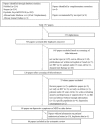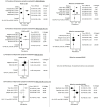Prevalence and factors associated with depression in people living with HIV in sub-Saharan Africa: A systematic review and meta-analysis
- PMID: 28783739
- PMCID: PMC5544236
- DOI: 10.1371/journal.pone.0181960
Prevalence and factors associated with depression in people living with HIV in sub-Saharan Africa: A systematic review and meta-analysis
Abstract
Depression, one of the most common psychiatric disorders, is two- to three-times more prevalent in people living with HIV (PLHIV) than in the general population in many settings as shown in western countries but remains neglected in sub-Saharan Africa (SSA). We aimed to summarize the available evidence on the prevalence of depression and associated factors according to the scales used and the treatment status in PLHIV in SSA. The pooled prevalence estimates of depression ranged between 9% and 32% in PLHIV on antiretroviral treatment (ART) and in untreated or mixed (treated/untreated) ones, with a substantial variability according to the measurement scale used and also for a given scale. Low socio-economic conditions in PLHIV on ART, female sex and immunosuppression in mixed/untreated PLHIV were frequently reported as associated factors but with no consensus. As depression could have deleterious consequences on the PLHIV life, it is critical to encourage its screening and management, integrating these dimensions in HIV care throughout SSA.
Conflict of interest statement
Figures



References
-
- UNAIDS. World AIDS Day 2015. On the Fast-Track to end AIDS by 2030: Focus on Location and Population. 2015. 2015.
-
- Deeks SG, Lewin SR, Havlir DV. The end of AIDS: HIV infection as a chronic disease. Lancet Lond Engl. 2013;382: 1525–1533. doi: 10.1016/S0140-6736(13)61809-7 - DOI - PMC - PubMed
-
- Abas M, Ali G-C, Nakimuli-Mpungu E, Chibanda D. Depression in people living with HIV in sub-Saharan Africa: time to act. Trop Med Int Health. 2014;19: 1392–1396. doi: 10.1111/tmi.12382 - DOI - PubMed
-
- Ciesla JA, Roberts JE. Meta-analysis of the relationship between HIV infection and risk for depressive disorders. Am J Psychiatry. 2001;158: 725–730. doi: 10.1176/appi.ajp.158.5.725 - DOI - PubMed
-
- Sherbourne CD, Hays RD, Fleishman JA, Vitiello B, Magruder KM, Bing EG, et al. Impact of psychiatric conditions on health-related quality of life in persons with HIV infection. Am J Psychiatry. 2000;157: 248–254. doi: 10.1176/appi.ajp.157.2.248 - DOI - PubMed
Publication types
MeSH terms
Grants and funding
LinkOut - more resources
Full Text Sources
Other Literature Sources
Medical
Research Materials

